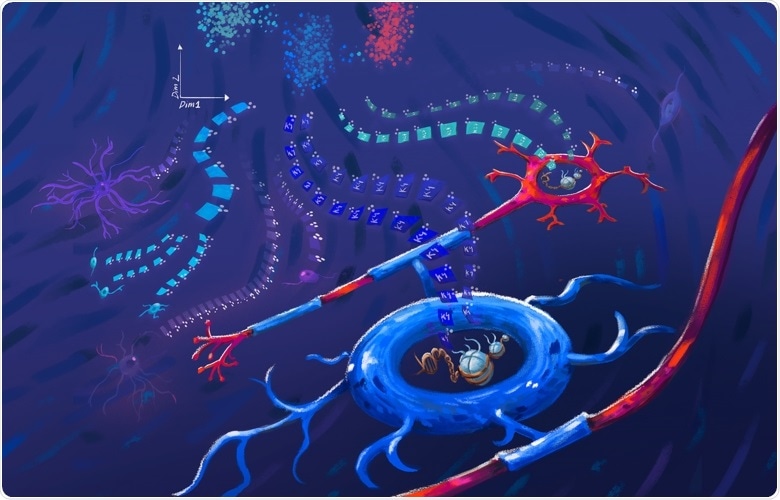Histones are essentially small proteins that attach to DNA and store information that can be used to switch individual genes on or off.

Decoding epigenomic information from individual cells from the mouse brain. Histones are attached to DNA as beads on a string, with different versions decorating the genome as “epigenetic stickers,” labeling which genes are turned on or off. The method single-cell CUT&Tag allows the examination of tens of thousands of single cells at the same time to determine their histone profiles. Image Credit: Amagoia Agirre.
Karolinska Institutet researchers have now created a method that allows them to analyze how different versions of histones attach to the genome in an unlimited number of individual cells simultaneously.
The new method was used on the mouse brain but it can also be used to investigate epigenetics at the single-cell level in other complex tissues. The research work was published in the Nature Biotechnology journal.
This technique will be an important tool for examining what makes cells different from each other at the epigenetic level. We anticipate that it will be widely implemented by the broad biomedical community in a wide variety of research fields.”
Marek Bartosovic, Post-Doctoral Fellow, Department of Medical Biochemistry and Biophysics, Karolinska Institute
Although all cells in the human body contain precisely the same genetic data written in DNA, they tend to read and apply this information differently. A neuron in the brain, for instance, reads DNA differently when compared to a fat cell or a skin cell. Epigenetics is essential in understanding genetic information and enables cells to perform specialized functions.
Beads on a string
One type of epigenetic information is histone modification. Histones are bound to DNA, similar to beads on a string, and adorn it as “epigenetic stickers.” Such stickers indicate which genes should be switched on or off. This mechanism collectively works together to make sure that scores of genes are turned on or off at the right time and place and in the right cell.
To gain a deeper understanding of how cells become specialized and different, it is critical to understand which sections of the DNA are labeled by which histone “stickers” in each specific organ and in every individual cell inside that organ.
It was impossible to examine the histone modifications of a single cell, until now. To investigate histone modifications in one particular type of cell, a large number of cells and time-consuming cell isolation methods would be needed. The final epigenetic histone profile of a specific type of cell would subsequently be an averaged view of an unlimited number of cells.
In this analysis, the team has defined a technique that provides them with a new way to examine the histone modifications in unparalleled detail in a single cell and on a wide scale. The researchers combined and further optimized other epigenomic approaches and managed to detect gene regulatory principles for brain cells in mice based on their histone profile.
Single-cell CUT&Tag
Our method—single-cell CUT&Tag—makes it possible to examine tens of thousands of single cells at the same time, giving an unbiased view of the epigenetic information in complex tissues with unparalleled resolution. Next, we would like to apply single-cell CUT&Tag in the human brain, both in development and in various diseases.”
Gonçalo Castelo-Branco, Associate Professor, Department of Medical Biochemistry and Biophysics, Karolinska Institute
“For instance, we would like to investigate which epigenetic processes contribute to neurodegeneration during multiple sclerosis and whether we would be able to manipulate these processes in order to alleviate the disease,” concluded Castelo-Branco.
Source:
Journal reference:
Bartosovic, M., et al. (2021) Single-cell CUT&Tag profiles histone modifications and transcription factors in complex tissues. Nature Biotechnology. doi.org/10.1038/s41587-021-00869-9.